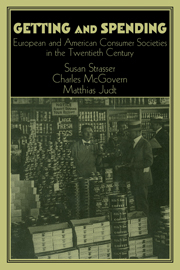Introduction
Published online by Cambridge University Press: 05 January 2013
Summary
For more than twenty years, American historians of the United States have been exploring the twentieth-century history of shopping, advertising, and marketing as the activities of individuals and as arenas for corporate endeavor. They have studied the meanings of consumer goods as material culture; they have investigated the history of consumer protest and other aspects of politicized consumption and consumerist politics; and they have traced the evolution of commodified leisure, a central feature of consumer society. This interest in the history of consumption is relatively new: For most of the twentieth century, most historians in both Europe and the United States have been preoccupied with the more overt agendas of politics and statecraft. Even the Annalesschool, which attended to the details and mechanisms of daily life in the evolution of economies, showed little interest in the emergence of modern consumer society. Some of the scholars affiliated with the Institute for Social Research in Frankfurt - especially Theodor Adorno, Max Horkheimer, Walter Benjamin, and Siegfried Kracauer - did provide a critical perspective on contemporary consumption and mass leisure in Weimar Germany and interwar Europe. But although that perspective fueled an appreciation of the origins of consumer society, the Frankfurt School never offered any detailed historical account.
Scholarly interest in the history of consumption first emerged during the Cold War, when, as a number of chapters of this book demonstrate, the issue of consumption became a major vehicle in the political and ideological clash of capitalism and communism and consumer goods were described as weapons in the Cold War. With desire for cars, washing machines, and less expensive goods regularly satisfied in the capitalist West but not in the state-socialist East, empty shelves became a sign of the failure of state socialism.
- Type
- Chapter
- Information
- Getting and SpendingEuropean and American Consumer Societies in the Twentieth Century, pp. 1 - 8Publisher: Cambridge University PressPrint publication year: 1998
- 1
- Cited by



